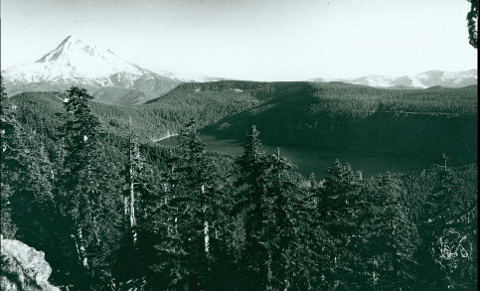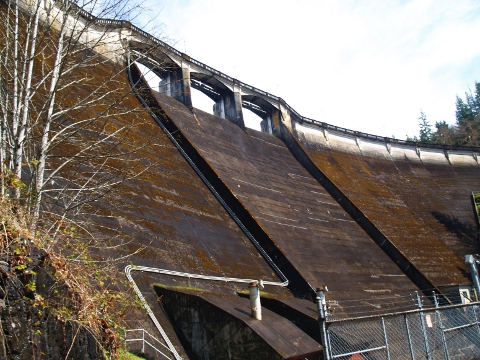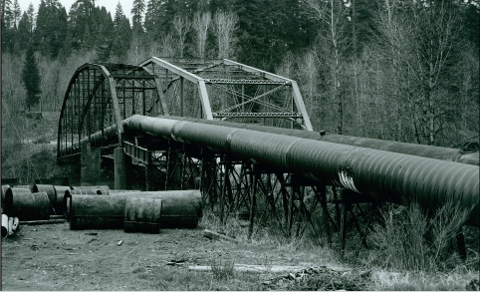Guided Tour
For those who are unable to access our Google Earth tour or seeking more information about our stops we provide this information.
Bull Run LakeBull Run Lake stands as the centerpiece of the 139 square mile greater Bull Run Watershed. The watershed was first surveyed by a private investor by the name of Charles Talbot in 1883, and subsequently purchased. In 1886, it was offered to Portland's Water Committee as a possible source of water approximately $130,000. Later that year, Bull Run was determined to be the most suitable source of water, but the asking price was deemed far too high. Eventually, questions arose surrounding the ownership of the lands surrounding parts of the Bull Run Watershed. After years of negotiation the Water Committee, armed with this information, offered $21,181.95 in 1888, which was promptly accepted. |

Bull Run Lake and Mt. Hood. Picture from Portland city archives. |

Dam 1 face. Picture by Keith McKinnon. |
Dam 1 and Ben Morrow LakeDue to Portland's significant population increases after the founding of the Bull Run Watershed, the newly created Water Board decided to increase the storage capacity of the Bull Run River. In 1927, the contract to build what is now known as Dam 1 was awarded to Bent Brothers Construction for the lowest bid of $1.44 million. Dam 1 was principally designed by D. C. Henny, who later went on to work on the design for Hoover Dam. Dam 1 itself is an arch shaped, concrete, gravity dam. Despite complications from both fire and floods, the construction of the dam finished both on time in 1929. Contrary to popular knowledge, the lake above Dam 1 is named Ben Morrow Lake in honor of the chief engineer overseeing the construction of the dam. |
Dam 2In the 1950, it became evident that once again the storage capacity of Ben Morrow Lake would not be sufficient to supply constant water flow during the dry season. So in 1956 the bureau began clearing land for a new dam. When construction finished, the earth filled rock faced Dam 2 stood 110 feet tall and held back seven billion gallons of water. |
Head Works FacilityOriginally, the headworks facility was only put in place when the conduits were built to regulate how much water was diverted from Bull Run River into the conduits for the city. After Dam 1 had been completed a chlorination plant was installed to help purify the water. From its installation in 1929 to 1997, the only chemicals added to the water supply were chlorine to disinfect and ammonia to stabilize the chlorine. In 1997, the bureau decided to add sodium hydroxide in order to reduce corrosion of pipes. |
ConduitsThe pipelines that carry water from headworks into the city are called conduits. Construction on Conduit 1 was started in 1893. Under the direction of Colonel Isaac Smith, the 24 mile pipeline was laid through Clackamas and Multnomah counties, which provided road construction for the majority of the area. After its completion in 1895, Conduit 1 was able to provide the city with roughly 25 million gallons per day (MGD). In 1907 it became clear to the water bureau that Conduit 1 would not be able to provide adequate water to the city, and thus began the process of building a second conduit. Due to legal complications, Conduit 2 was not finished until 1911. When brought online, Conduit 2 provided an additional 50 MGD. In 1925, Conduit 3 was finished in order to once again improve supply capacity by adding an additional 75 MGD, doubling the transportation capacity. Later in 1952, Conduit 4 was added to the system, adding an additional 100 MGD. The installation of Conduit 4 allowed the retirement of Isaac Smith's now 57 year old Conduit 1, which was far too small and leak prone to continue operation. |

Conduits 2 and 4 near headworks. Picture from Portland city archives |
Columbia South Shore Well FieldsBecause the Portland water system relied solely on Bull Run for supply, in the 1970's the bureau commissioned a study for possible secondary sources of water. Of the three possible sources, the Willamette River, the Columbia River, and groundwater, it was decided that groundwater would provide the cheapest alternative. Luckily, a suitable site in the Columbia South Shore area lies in close proximity to the Powell Butte reservoir which allows water from the well field to be added into the system directly instead of serving a specific section of the city. The well field was finished in 1984 and can provide an additional 50 MGD to the city. Due to the cost of running the wells, the Columbia South Shore Well Field is only used to provide water to the city during short period of high water demand during dry seasons and when Bull Run water exceeds federal mandated turbidity levels. |
Major Reservoirs
When the original Bull Run system was built, four reservoirs were built to store water within the city. Reservoirs 1 and 2 were built on Mt. Tabor and Reservoirs 3 and 4 were built in what is now known as Washington Park. These four reservoirs had a combined storage capacity of 66 million gallons. In 1911, Reservoirs 5 and 6 were added to the system at Mt. Tabor and added an additional 125 million gallons of storage. During the 1970's, Reservoir 2 was permanently taken offline due to it consistently being the most polluted, most difficult to maintain and least capable of supplying its own customers with adequate pressure. In 1981, the Powell Butte reservoir was completed to add an additional 50 million gallons of storage to the system. Furthermore, Powell Butte became the new end point for the pipelines from headworks into the city.
